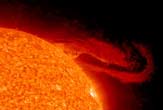
NASA's twin STEREO spacecraft are offering the first glimpse of the far side of the sun, the space agency announced today.
The two spacecraft, launched Oct. 25, 2006, are beaming back over-the-horizon images "that have researchers and forecasters glued to their monitors," according to a statement.
"This is a perspective we've never had before," says STEREO mission scientist Lika Guhathakurta of NASA headquarters. "We're now monitoring more than 270 degrees of solar longitude - that's 3/4ths of the star."
Just in time
Because the sun rotates, all of it is seen from Earth over time. But at any given time, only half of the star is visible. Scientists who monitor solar eruptions and the space storms they hurl toward Earth are eager to monitor the whole star 24/7. Seeing storms on the far side, which is of course just as bright and active as the near side, would improve forecasting abilities.
"After all these years," Guhathakurta quipped, "we're finally getting to see the dark side of the sun."
Since the two STEREO spacecraft went into orbit around the sun at the beginning of 2007, they have been slowly drifting apart from Earth, and from each other. They are now 90 degrees apart. They will be in their final positions on Feb. 6, 2011, hovering 180 degrees apart and imaging the entire sun all the time. That timing will match with the next expected peak in solar activity.
The sun is at a low point in it's 11-year cycle of activity now. But over the next few years, sunspots will become more common and flares more frequent. The peak will likely occur in 2012.
Dangerous solar storms can happen anytime, however. A major one, thought to occur every 100 years or so, could debilitate communication and power systems on Earth, according to a National Academy of Sciences report earlier this month.
Already better
Because of the way the sun spins, STEREO-B gets a sneak preview of sunspots and coronal holes before they rotate around and face Earth.
"I know forecasters at NOAA's Space Weather Prediction Center monitor STEREO-B very closely," said Chris St. Cyr of the Goddard Space Flight Center. "It lets them know what's coming."
Already, STEREO-B enjoys a 3-day look-ahead advantage over Earth-based observatories.
No images were released today. However, the probes are equipped with sensors that measure the speed, direction and composition of the solar wind; receivers that pick up radio emissions from explosions and shock waves in the sun's atmosphere; telescopes that image the solar surface and all the tempests that rage there; and coronagraphs to monitor events in the sun's outer atmosphere.
"So, really," says Guhathakurta, "we're not only seeing the sun's dark side, we're feeling, tasting and listening to it as well."
Gallery: Solar Storms
Video - Space Storm Warning
Perfect Space Storm Could be Catastrophic on Earth, Study Concludes



Reader Comments
to our Newsletter